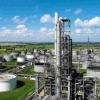|
|
Temperature Fluctuation In Distillation Column
#1

Posted 18 February 2008 - 08:40 PM
Recently, one of the distillation columns in our plant is behaving strangely as temperature profile of the column is fluctuating.
This column is a vacuum column, using sieve trays. It has two liquid phase (oil and water phase).
As we have 7 TRs from top to bottom of the column, we managed to monitor temperature fluctuation across column. Temperature profile is fluctuating the most near the feed section with fluctuation of about plus minus 20 deg.C (temperature at this section will slowly reduce and then increase and reduce again with one cycle takes about 20 min.)
In actual fact, all TRs profile is fluctuating at the same time, but fluctuation is the least at tower top and bottom.
A few points to highlight:
1. No indication in reduction of tray separation efficiency. Top and bottom specs can be maintained at normal reflux ratio.
2. Although bottom pressure is fluctuating together with temperature, on average there is no evidence of higher pressure drop if we were to compare with operating condition when temperature is not fluctuating.
3. Temperature fluctuation first started after half a year of plant operation from the previous shutdown. Sometimes, temperature fluctuation will stop by itself without any adjustment to plant operation and it will then start again.
4. Gamma scanning has been performed for this column. Vendor suspected that there is possibility of tray collapse inside distillation column. However, during plant shutdown we inspected this column and found nothing unusual. All trays are in perfect condition.
5. This is not a new plant, and in fact plant has been operation for many years without any problem of temperature fluctuation at all. No modification was done at this column when temperature profile first started.
If anyone has any opinion the cause of this strange phenomenon, please share with me.
Thank you so much.
#2

Posted 18 February 2008 - 09:51 PM
Once the temp decreases, is that the steam to reboiler increases and brings up the temperature?
#3

Posted 18 February 2008 - 10:30 PM
Sorry I forgot to mention. Due to temperature fluctuation, steam flow rate is not cascaded to tower temperature. As such, steam flow rate is kept constant throughout.
#4

Posted 19 February 2008 - 06:54 AM
I have a little operational experience on the basis of that I have a general observation as temerature goes up after pressure goes up i.e. temperature profile always follow the pressure profile provided all other conditions like comopositions and all remain steady.
This is really interseting for me like you to know the reason. If your pressure drop across the column, flow and the compostions of the column feed and reboiler steam flow are also constant then one parameter I would like to give an emphasis is the pressure control of the column but I am not sure if the PT is giving wrong signal to your Pressure Controller your other pressures like bottom pressure and pressure drop variation will give the indication of the same.
When I am writing the reply to your query my process engg basics don't allow to accept this phenomenon as there is only variation in one parameter and there is no effect of this on other parameter. It looks something very strange. Just me too waiting to see the comments of others.
#5

Posted 19 February 2008 - 08:53 AM
Have you checked if the feed flow is stable? You may change the flow control to manual to fix the control valve position to stabilize feed flow. Sometimes the controller may send wrong signal to the control valve.
Joe
#6

Posted 19 February 2008 - 06:28 PM
Actually initially i had the same opinion as you. But after investigating, there is no problem with top PC control at all. Although there is minimum fluctuation of top pressure and bottom pressure as temperature fluctuates, but in this case I tend to think that pressure fluctuates due to temperature and not the other way. To further confirm, I have tried to put top PC control in manual, but temperature still fluctuates.
As for JLMontreal queries: yes, I have checked and confirmed that feed flow is stable. Feed composition is monitored regularly and showed stable reading as well.
Thanks.
#7

Posted 20 February 2008 - 06:14 AM
Could you upload the details about the feed and the column in an excel sheet so that we will get the clear idea about the query.
This query is stretching my curiosity.
#8

Posted 20 February 2008 - 08:42 AM
Without disclosing your confidential info, can you provide more details about feed, incl. temperature, pressure, control loop(by LRC or FRC?), particularly those data during fluctuation?
As per heat balance, this fluctuation is caused by one variable stream( in flow, temperature, pressure), most probably the feed.
Did you analyse the average value of the fluctuating temperature, above or below normal value?
How is the status of the upstream equipment during fluctuation, from which the feed comes?
How is the fluctuation frequency? once per shift or more? it happens more often in daytime or envening? winter or summer?
Is there any other problem happening earlier in other related equipments before this fluctuation?
Good luck.
Joe
#9

Posted 20 February 2008 - 11:09 AM
The problem is a very interesting one, and I think much more field data has to be provided from your side.
Simply, if all instruments are correct (1st statement - I consider it to be 100% confirmed), and there is no change in feed flow, composition, column heat input and heat removal (2nd statement), and products spec (3rd statement - this is a tricky one, because it is a big question whether you can take representative samples reflecting tower upset conditions), I think there is not much space left to continue with troubleshooting.
We definitely need a PFD of the column, with detailed sequence of events - written in the form of bullets. I've seen many times in my career that columns can behave in a very wierd manner, but there was always a logical explanation and direct cause-effect relationship.
If you can provide additional info, that would be a big step forward.
Best of luck,
#10

Posted 23 February 2008 - 07:31 PM
Thank you for all the comments that I have received so far. I do understand very well from the beginning that it's possibly difficult to know the root cause of the problem without giving the information in details. However, I do have to admit that the company that I'm working in is strict on this issue, and therefore there is limited amount of information that I can furnish.
To answer your queries:
Yes. As I mentioned earlier, the fluctuation is about plus minus 20 deg.C, and the average temperature is similar with temperature when the tower doesn't fluctuate.
Feed to this column is coming from other column, and there is no abnormalities observed, in terms of flow rate, pressure profile as well as temperature profile in this column.
Fluctuation frequency seemed to be random. At times, it will stop by itself after 1 day, but there were times when fluctuation is continuing for one month.
No. We had shutdown period in which I took the opportunity to inspect all the equipments and column internals. No problem was found.
This is the information that is difficult for me to furnish. However, I would like to emphasize that during temperature fluctuation period, we operated this column without relying on control loop. (Plant operator operates all control valves manually instead of relying on FC/LC control).
Lastly sorry for my late reply. I have been pretty much occupied with my work recently.
#11

Posted 24 February 2008 - 06:01 AM
Have you measured the composition of the feed during temperature fluctuations?
Since we do not know much about the process scheme, we can only speculate as to what may be happening, and one such thing that comes to my mind is : check for tube rupture in the reboiler of this column and also the ones upstream as well as downstream. I'd like to refer you the the first case study by Henry Kister in his book "Distillation Operation", wherein a tube rupture in the debutanizer reboiler led to unstable operation.
hope this helps,
abhishek
#12

Posted 25 February 2008 - 10:40 AM
With little information, we can only speculate. Therefore, I will feel freee to do so. To me it sounds as if your trays may be experiencing some sort of hydraulic instability. Picture the level(s) building up on a tray or series of trays. Gas pressure below this point(s) would rise to overcome extra head. Finally, this cannot be sustained, and the height of liquid overcomes the dP, resulting in a (perhaps small) surge in liquid flow. This is followed by a surge in gas flow and a pressure decrease, since now the liquid opposing the upward gas flow is less. At the conclusion of this cycle, liquid and gas again begin to accumulate for a repeat performance. If you have two liquid phases, something similar could occur regarding the relative amounts of the two phases.
Though I pride myself in being practical, please do not ask me for a workable solution to this problem. I have none.
#13

Posted 27 February 2008 - 04:58 AM
You are right, this column has two liquid phase. The good thing is that it doesn't impact plant, but then although the problem has started since more than one year ago, and the operation people always pressing us for advice, unfortunately we still haven't managed to find any workable solution yet.
#14

Posted 27 February 2008 - 09:10 AM
You might try to reduce load on the column. As you move away from flooding, the tray differential pressures will decrease. If my theory (speculation) is correct, the problem would probably disappear at some point as the reduced pressure gradients lose the ability to generate accumulations of the fluids.
Doug
#15

Posted 29 February 2008 - 03:28 AM
1. Composition induced flooding (component accumulation inside the tower, flooding occurs in cycles). See attached article: http://people.clarks...gn/comptrap.pdf
2. Decoupling of tower bottoms flow control, if product is feeding two separate downstream units, or if part of the product is sent to storage tank.
If Doug is correct (and we all are still speculating here - because input data is insufficient), one of possible ways to combat against flooding is to increase tower operating pressure. Especially if column throughput is close to design conditions.
Best of luck,
#16

Posted 06 March 2008 - 08:35 PM
We are working the design and fabrication of column internals.
we believe the problem must be from the feed condition. Two liquid phase may need to be cosidered. if u can provide the following information, we believe we can find the fact.
- Feed conditions - including rate, composition & temperature;
- Column operation conditons (normal); and,
- Changes in column pressure during the 20 min cycle.
============================
John Huang
International Business Dept.
Beijing Zehua Chemical Engineering Co., Ltd.
http://www.zehua-chem.com
Tel: 8610-59798376 ext 251
Fax: 8610-62980607
MSN:Hzy0648@hotmail.com
#17

Posted 07 March 2008 - 12:43 AM
So in the next stage U should check the tray from outside sight glasses if possible & try to see through sight glass for any abnormal liquid level on trays during fluctuations. This may give you some idea.
#18

Posted 10 March 2008 - 08:01 PM
#19

Posted 13 March 2008 - 05:30 AM
Also you say that, you have manually checked all the feed trays, I can not think of anything which will cause a change in hydraulic behaviour of the plates.
If temperature varies around the feed tray...we must try to think of something in the vicinity of feed tray...
#20

Posted 22 March 2008 - 12:06 PM
I am curious to know if temp fluctuation in the column is fixed? Please update your findings to share some unique problems like this to rest of the engineers in the world.
Thank You
Roops
#21
 Guest_lightyear_ray_*
Guest_lightyear_ray_*
Posted 23 March 2008 - 09:29 PM
#22

Posted 24 March 2008 - 02:37 AM
Thank you for comments from all.
I'm sorry for not replying recently, because I have been very busy with other assignments recently. In fact, I am currently travelling to other country, making me not knowing updates of my plant situation very well. However, based on information from my colleagues, it appears that we are still experiencing temperature fluctuation until now.
However, some comments that I would like to add:
1. To zehuachem. Actually temperature dropping and increasing rate is almost the same.
2. To pawan. I agree with you that choking seems to be the possible reasons. Normally, after shutdown, temperature fluctuation starts to occur only after a few months of stable operation. In the first few months, temperature profile is stable.
3. To zauteberg. Thanks a lot for your article. However, I have experience in other distillation column on composition induced flooding. Based on my understanding, normally temperature fluctuation frequency will be slow, am I right? One cycle probably will take a few hours. But in my case, one cycle takes only about 5 min.
4. As for discussion to reduce tower load. I don't know whether it will help or not. But more importantly, we can't afford to do that, as even with temperature fluctuation we can operate our plant at full load. So, it's difficult to convince management to reduce plant load just because of something that we can handle even if we can't solve the problem.
Anyway, thanks a lot for all your comments.
Best regards,
David
#23

Posted 02 April 2010 - 06:03 AM
As far as lowering the production rate is considered for lowering the flooding , you mayy have the same effect by increasing the column pressure .Try increasing the column pressure very slowly .
Just for a far reaching try ,have you notices any thing like a hammering in the feed inlet line ,How is your feed inlet line ,is it properly sloped or does it have pockets .In case if there is some chocking in the feed inlet line or if there is a possibility of a pocket you line may have liquid accumultions and your column may recieve slugs of liquid at intervals
I must say this thread is intresting ,whenever you find a solution do let us know
Similar Topics
Packaging And Gas Velocity In Packed ColumnStarted by Guest_ChemEng_CristianoB_* , 25 Jun 2025 |
|

|
||
Distillation Column Reboiler QuestionsStarted by Guest_AlanC079_* , 07 Jul 2025 |
|

|
||
Pipe Fluid Temperature Increase Due To Solar LoadingStarted by Guest_HeemeshJ126_* , 06 Apr 2016 |
|
|
||
Distillation Column Top PressureStarted by Guest_halkeshhulk_* , 27 Jun 2025 |
|

|
||
Distillation Column Top & Bottom TemperaturesStarted by Guest_halkeshhulk_* , 09 Jun 2025 |
|

|

 FB
FB












